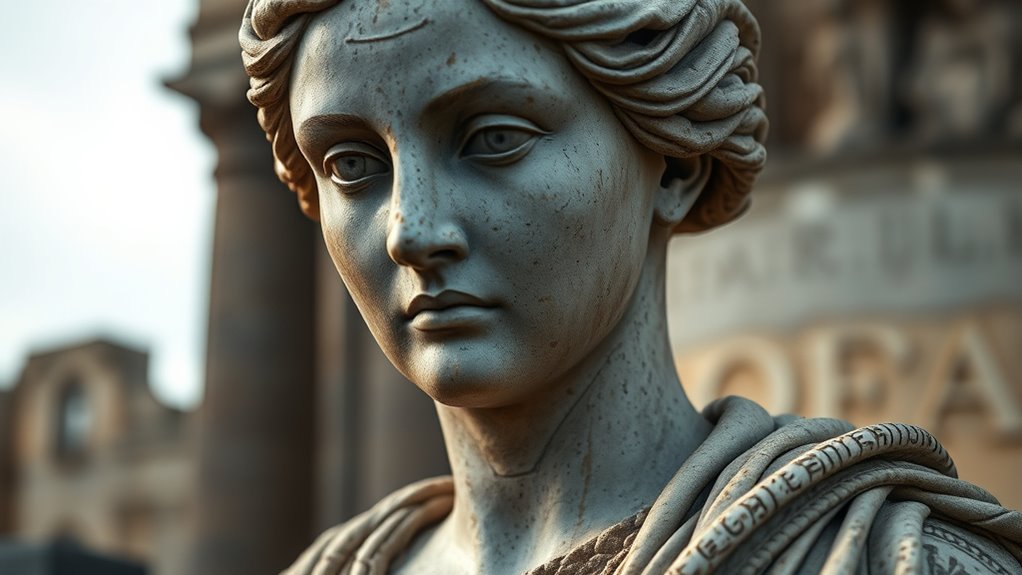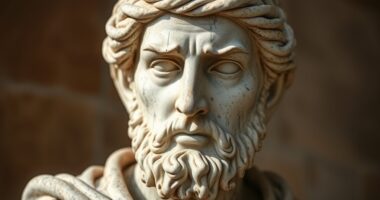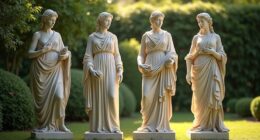Porcia Cato exemplifies resilience and Stoic strength as a woman steering Rome’s political chaos and personal loss. Her strategic marriages linked her to key political figures, supporting her husband’s cause and demonstrating unwavering loyalty. Despite tragedy, her life reflects emotional resilience, discipline, and courage. Her story inspires us to withstand adversity with steadfastness. If you continue exploring her story, you’ll discover even more about her remarkable resilience and influence.
Key Takeaways
- Porcia Cato exemplified Stoic resilience through unwavering loyalty, emotional strength, and endurance amid political upheaval and personal tragedy.
- Her strategic marriages reinforced family power and societal influence, reflecting Roman values of alliance-building and resilience.
- She supported Brutus’s cause during Julius Caesar’s assassination, demonstrating steadfast loyalty and emotional resilience.
- Symbols from myth and tradition, like Hercules and Athena, highlight her cultural significance as a model of strength and bravery.
- Her life teaches practical lessons on inner discipline, emotional resilience, and maintaining integrity amid chaos and adversity.
The Life and Legacy of Porcia Cato

Porcia Cato lived during a turbulent period of Roman history, and her life reflects both her personal resilience and her enduring influence. She navigated ancient marriage customs and Roman family dynamics with strength and independence. Her marriages, arranged for political alliances, exemplify Roman practices, yet her loyalty and boldness set her apart. As Cato’s daughter and Brutus’s wife, she embodied Stoic virtues of endurance and fidelity. Her story of courage, loyalty, and philosophical resilience continues to inspire, symbolizing the strength women showed amid chaos. Porcia’s legacy endures as a powerful example of steadfastness in a tumultuous era.
Marriages in Roman Society and Porcia’s Alliances

Marriages in Roman society were often strategic rather than driven by love, serving to strengthen political alliances and secure family power. You notice that marriage customs emphasized alliance-building, with fathers arranging unions to benefit their political standing. Porcia’s marriages exemplify this, as her union with Bibulus linked her to prominent allies. Her marriage to her cousin Brutus reinforced political ties and solidified opposition to Caesar. These alliances weren’t just personal but deeply rooted in Roman practices to advance family influence. Understanding these customs helps you see how Porcia’s alliances were crucial in charting the turbulent political landscape of Rome, highlighting her role within broader societal strategies. Additionally, the importance of alliances in Roman society underscores how marriage was a key tool for political and social leverage.
Porcia’s Role in the Assassination of Julius Caesar

Although her direct involvement remains uncertain, Porcia’s loyalty to Brutus and her commitment to the Republican cause suggest she played a significant, if indirect, role in Julius Caesar’s assassination. She navigated political intrigue and familial conflicts, supporting Brutus emotionally and psychologically. Her actions possibly included:
- Encouraging Brutus’s resolve through private conversations.
- Demonstrating her loyalty by enduring personal pain.
- Creating a supportive environment amid Rome’s chaos.
- Symbolizing Stoic resilience amidst political upheaval.
Additionally, her understanding of second trimester developments and the physical and emotional changes women experience during this period may have influenced her resilience and capacity to support Brutus during turbulent times. She recognized the importance of health benefits such as emotional strength and physical well-being could have further empowered her in challenging circumstances. Building on this, her awareness of psychological resilience might have helped her maintain focus and composure under pressure.
Furthermore, her ability to maintain composure and resilience can be linked to her emotional stability, which was crucial in navigating the complex political landscape of Rome. Her capacity for cultural intelligence likely aided her in understanding and managing the diverse perspectives within her social environment, thus strengthening her support for Brutus.
The Dramatic Story of Her Death and Its Interpretations

The circumstances surrounding Porcia’s death have captivated historians and storytellers for centuries, blending fact and legend into a compelling narrative. Some say she swallowed hot coals in grief, symbolizing the depths of her pain and loyalty. Others suggest illness or poisoning, emphasizing her vulnerability. Despite the mystery, her death reflects powerful grief symbolism and resilience. Historians debate the historical accuracy, noting her letters hint at illness before Brutus’s battles. Her tragic end underscores her unwavering loyalty, inspiring interpretations of stoic endurance amid despair. Additionally, the historical context of her life and times offers insight into the possible reasons behind her death, highlighting the complex interplay between legend and documented history. The cultural significance of her story demonstrates how her legacy has been shaped over centuries, blending myth and history to reinforce themes of loyalty and stoicism. Furthermore, understanding the personal resilience she exhibited can shed light on the enduring appeal of her story across generations. Recent research into her life reveals new perspectives that challenge traditional narratives and deepen our understanding of her character, including the influence of Roman societal values on her portrayal.
Stoic Principles Embodied in Porcia’s Actions

Porcia’s actions exemplify core Stoic principles such as resilience, loyalty, and self-control. Her virtuous endurance and inner strength shine through her willingness to endure pain and hardship for her beliefs and loved ones. She demonstrates how to maintain composure amid adversity, embodying Stoic discipline. Her approach to emotional resilience emphasizes the importance of inner fortitude in facing life’s challenges. Her life teaches that true resilience is rooted in inner discipline and steadfastness. In adopting these principles, she reflects an understanding of psychological resilience as a vital aspect of overcoming adversity through mental strength. Additionally, cultivating creative practice can serve as a means to develop such resilience, as it encourages experimentation and acceptance of failure as a part of growth. Engaging in mindfulness techniques can further enhance one’s capacity to remain centered and resilient in the face of difficulties. Incorporating goal setting strategies aligned with personal values can also reinforce resilience by providing clear direction and purpose.
Resilience Through Hardship: Practical Lessons From Porcia’S Life

Facing adversity with strength, Porcia teaches us valuable lessons on resilience through hardship. Her emotional resilience shines as she endures pain, grief, and danger, demonstrating unwavering inner strength. Practical endurance is evident in her willingness to face suffering—whether through self-injury to prove loyalty or surviving illness amidst chaos. She shows that resilience isn’t just about enduring physically but also maintaining mental fortitude. By embracing simple living and Stoic principles, Porcia models how to stay steadfast in tough times. Her life reminds us that resilience requires inner discipline, adaptability, and courage—traits that help us navigate life’s unpredictable challenges with grace. Incorporating protective styling benefits, such as crochet styles for locs, can serve as an analogy for how resilience involves safeguarding our inner strength while adapting to external pressures. Additionally, understanding sound healing science highlights how external stimuli can influence our mental resilience and overall well-being.
Love and Loyalty Amidst Political Turmoil

Throughout her life, Porcia exemplified unwavering love and loyalty, even when political chaos threatened to tear her apart. Her dedication shone through her marriage to Brutus, who faced Roman architecture’s grandeur while maneuvering treacherous alliances. Her loyalty transcended ancient fashion’s modesty, embodying Stoic resilience amid turmoil. She stayed true despite external gossip, familial rivalry, and danger. Her steadfastness teaches you that true love endures through hardship. Embracing inner strength helped her withstand external pressures and maintain her integrity. By applying fraud prevention tools, she could have better protected her reputation from malicious rumors and false accusations. Understanding toilet maintenance and repairs could have also helped her address any personal or household issues discreetly, preserving her dignity. Cultivating emotional resilience allowed her to navigate complex relationships and political threats with grace.
Enduring Symbols of Strength and Courage in History

Enduring symbols of strength and courage in history serve as powerful reminders of the human capacity to face adversity with resilience. Ancient rituals often honored mythological symbolism that embodied bravery and steadfastness, like the Spartan phalanx or the Roman triumph. These rituals reinforced societal values, inspiring individuals to embody qualities of endurance and valor. Mythological symbols, such as Hercules’s labors or Athena’s wisdom, represent resilience amid hardship. By understanding these symbols, you see how societies celebrated resilience through ritual and myth, encouraging individuals to confront challenges boldly. Recognizing cultural symbols and their meanings enhances our Cultural Intelligence, allowing us to better appreciate diverse expressions of resilience. These enduring images continue to inspire modern resilience, reminding us that strength often arises from facing adversity head-on.
Frequently Asked Questions
What Specific Philosophical Beliefs Influenced Porcia’s Actions?
You see, your actions are often shaped by specific philosophical beliefs. In Porcia’s case, Stoic virtue and ethical resilience drive her behavior. She embodies self-control, loyalty, and steadfastness, even amid chaos. Her willingness to endure pain and hardship reflects her commitment to living ethically and resiliently. This Stoic influence guides her to face adversity with courage, demonstrating that true strength lies in inner resilience and unwavering moral principles.
How Accurate Are the Stories About Porcia’s Death?
Think of the myth versus fact debate when evaluating Porcia’s death story—historical accuracy remains uncertain. While tales of her swallowing coal are dramatic, many historians believe she likely died from illness before Brutus. The stories may be romanticized or exaggerated, reflecting cultural ideals rather than strict facts. So, you should view her death as a mix of legend and possible reality, acknowledging the gaps in historical evidence.
Did Porcia Have Any Children Besides Her Son?
You might wonder if Porcia had children beyond her son. Historical records mainly mention only her son, so her motherhood legacy appears limited. Her family dynamics focused on her marriage to Brutus and their shared loyalty, but no other children are documented. Despite this, her influence endures, symbolizing resilience and love. Her role highlights how even with limited offspring, her strength left a lasting mark on history and cultural memory.
How Did Porcia’s Family React to Her Marriage With Brutus?
They say “family is everything,” but Porcia’s family had mixed feelings about her marriage to Brutus. Her father, Cato, valued duty and social expectations, likely disapproving of her union with a political outsider. While some family members might have supported her loyalty and love, others opposed her choice, fearing political repercussions. Despite this, Porcia’s love and resilience shone through, proving that personal conviction can sometimes defy social norms.
What Sources Provide the Most Detailed Accounts of Porcia’s Life?
You’ll find that ancient manuscripts, like those by Plutarch, offer the most detailed accounts of Porcia’s life, revealing her character and actions. Modern biographies also explore her story, adding context and analysis that ancient texts lack. Together, these sources give a holistic view of her resilience, loyalty, and significance in history, allowing you to understand her enduring legacy through both historical and contemporary perspectives.
Conclusion
Porcia’s story is a beacon of resilience, shining through the shadows of Rome’s chaos. Her unwavering strength and steadfast loyalty prove that true courage burns brightest in the darkest times. Like a sturdy oak weathering fierce storms, her legacy reminds us that even in the face of adversity, our inner resolve can inspire history. Embrace her spirit—let resilience be your guiding light amid life’s tempests.









